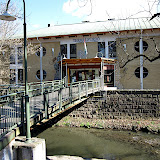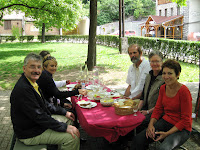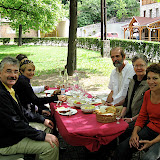 Documenting a Professional Development Activity through Blogging: Example and Advice
Documenting a Professional Development Activity through Blogging: Example and AdviceOff Off Campus: Teaching from Hungary is a multimedia blog consisting of over 80 entries, and constructed using Google’s Blogger. The purpose of the blog was to document my experiences during a four-month faculty exchange to the Institute of Media Informatics at Eszterházy Károly College in Eger, Hungary. As a professor of Curriculum and Instructional Technology at Valdosta State University, I was very experienced in delivering instruction from a distance. In fact, I continued to teach Valdosta State students online throughout the Hungarian exchange experience. I knew there would be some challenges in teaching at such a distance, mostly in relation to the time difference, and possible technology differences. The title of the blog anticipates the challenges of a long distance educator.
I’d never blogged before, but thought becoming a blogger would be a good immersion technology learning experience, as well as a good way to communicate my adventures to colleagues, family, and friends back home in the U.S. I conceived the blog as a work of academic scholarship as well, that is, a web publication relevant both to my academic discipline, instructional design and technology, and to the experience itself, international education. Since I saw this as a professional blog, I wanted the entries to convey meaningful information about educational and cultural experiences in Hungary, as well as about the experience of being on faculty exchange in a culture quite different from South Georgia, U.S.A. I didn’t intend to write a travelogue; I wanted a more general focus. As I worked on the blog, I found that I recalled my background in journalism and advertising, creating something that was more similar to an online magazine than anything else. Over time and varied topics, I used multiple writing styles, levels of formality, and illustration and graphic methods.
As in many technology-related tasks, doing is learning when it comes to a blog. Since the outcome of this project was intended to be educational, I did employ the first steps of the instructional design process by defining goals, purposes, and objectives for the blog, and considering the target audience(s). I came up with a very general framework as the underlying structure for the blog: teaching, learning, culture, and fun. It was my intention to categorize each blog entry under one of these headings as the main topic, and to try to balance my writings among the topics. Along the way, I jotted down discoveries, ideas, advice, and recommendations that would be helpful to anyone else who might use a blog to document a particular professional experience or interval. This article is a summary of what I learned and observed while creating Off Off Campus. Some of the following advice may seem relevant only to my particular project; other advice is more general.
Advice: Have a frameworkAs indicated above, I didn’t just start blogging. I started with a purpose and a framework. Without that structure, I think it would have been tempting to just report on happenings in a chronological way. With the framework, I often found myself writing on themes (e.g., transportation), and then combining a number of events and observations (e.g., a particular bus adventure, a harrowing ticket-buying experience, a comparison of US/Hungarian drivers) into one blog entry. I also think the framework really assisted me in staying focused and reflective about my teaching and learning.
Advice: Think of your audience(s)I began the blog with a sure audience of one—me. I wanted a contemporaneous, multimedia record of my time in Hungary. “Post-production” activities such as creating photo books and DVDs have taken me considerable time following other overseas trips. I wanted to come back from this trip with my full experience in a ready-to-share format. I increased the likelihood that I would stay with the task by making it the basis for a conference presentation proposal (accepted for presentation 23rd Annual Conference on Distance Teaching and Learning, August, 2009).
The next audience I considered consisted of my Valdosta State University departmental and college colleagues, as well as other faculty interested in International Exchange opportunities. They wanted to share the adventure with me, and several had actually been to Eger a couple of years earlier for a conference, and would be revisiting places and people they knew through the blog. So, the blog had to be professional in tone, but interesting, with enough detail to communicate my activities. Most importantly, there couldn’t be too much emphasis on having fun—after all, I was working!
Family, friends, and current and former students were also invited to read the blog, in most cases, in lieu of exchanging emails. There just wasn’t time to do both. One elderly aunt and uncle became such followers that they printed each entry and send it to other relatives who lacked Internet access. A former student became my ‘perfect follower’, willing to leave comments and troubleshoot Blogger features. My current U.S. students, whom I was teaching via distance during the exchange time period, were an audience, too. I hoped they would take an interest in the novelty of having a professor who was six hours removed in time zones. Some did, and would make comments in the blog. However, we had so much direct (and usual) contact within the course management system, that they didn’t have the time or inclination to spend much more time with me by visiting the blog.
The audience of which I was very aware, and somewhat uncertain, consisted of my Institute of Media Informatics colleagues and administrators of the college in Hungary. Although I informed them of my blog from the beginning, and even used it as an illustration of how they might use blogging in their instruction, I wasn’t sure of their level of interest. It was quickly communicated, however, that many of my colleagues were my closest followers, and they would ask me questions, for example, about how I liked last night’s concert (that I’d blogged about), and add to my knowledge about events I’d observed. I was a little self-conscious sometimes about writing, knowing that people involved in what I was reporting were reading it. However, response was very positive.
Advice: Illustrate your blogI take lots of digital photos and really find it natural to illustrate my writing with graphics. I found myself taking photographs in a different way than on most trips, more journalistically than artistically. I would anticipate writing a blog entry and then purposely take photos that would carry some of the meaning. Thus, photos of street signs, posters, and products in stores were often more useful than beautiful sunsets, flowers, and mountain scenes. Photos didn’t have to be great, just representational, and simple enough to convey meaning in the small scale display within a blog entry. In fact, I came to realize that using a ‘great’ photo in the blog was somewhat wasted, and a bit frustrating for the viewer to not be able to enlarge or see it in full resolution. I saved those few ‘great’ photos for printing when I got home.
Organization of digital photos is always a challenge, especially when on a long trip. Knowing that I was going to be inserting photos into blog entries really helped me stay organized. I took photos, and then downloaded them from my camera card onto my laptop. I used iPhoto albums, named to indicate specific topics. Some photos from the iPhoto library went into more than one album, if they would be useful for illustration of more than one entry. I kept the iPhoto library intact, and backed it up on CDs for safety.
In some cases, such as substantial out-of-town trips, I knew I would upload the album to Picasa, and then insert a link to the Picasa album within the blog entry. For those albums I tried to be very careful to edit the photos for quality, remove any photos that I didn’t want to be public, put the photos in a “storytelling” order, and, sometimes, add caption names to the photos so the titles would be displayed in a Picasa slideshow. There are choices as to how to offer viewers access to Picasa albums, and I utilized them all at different places in the blog. A simple URL link sends the blog reader to the Picasa album where he can look at the photos one by one, or see them in a slideshow. If you create a Picasa slideshow, with titles, you can either insert a link to that slideshow, or you can embed the slideshow, which actually plays the slideshow within your blog entry.
On other topics, I knew I would simply want to choose a few photos to insert directly into the blog. Those albums were private, only available on my own laptop, and so didn’t get quite the scrutiny for editing as did the public albums.
Inclusion of photos of people in the blog was a bit tricky. I tried to ask permission of anyone I would include, and made sure that photos of children were absent or not identifiable. When I did include people in a blog, whether in photo or content, I would tell them or email them a friendly notification and ask them to please tell me if they wanted me to edit or remove. I didn’t ever get a request to alter a blog entry—everyone seemed flattered and happy to be ‘published’. I hope that was because I was always cognizant of my audience(s), and tried to see my writing and photos through their eyes as well as my own.
I can share some specific photo ideas that were useful to me in the international context. Take the same photo from the same place over time—that was a great way to document change over time (e.g., the long awaited arrival of Spring). Take photos of posters for events—great to take home and use a dictionary to translate, and then use as illustration of the description of the event (and reminder of date/place/correct spelling) in a blog entry. Make PowerPoint slides into jpg graphics and use as illustrations in the blog, whether as an original custom graphic, or to represent an actual presentation or class. I also used SlideShare.com to store my PowerPoint presentations and sometimes included links to those presentations within the blog entry.
It’s possible to upload movies into blog entries, and I did so occasionally. I took the movies on my digital camera, uploaded into iPhoto, and then inserted directly into the blog entry. I had mixed reports from viewers as to whether the movies worked very well, but even to have a tiny 10 second glimpse/sound of a gypsy violinist added atmosphere. Keep the movies very short and small, and realize that the sound is probably more important and clear, than the picture. In one case I did want to include a longer movie (walking the 192 steps to my office). I didn’t want to embed that in an entry, so I put it up on YouTube and created a link to it within the blog.
Advice: Prepare, then writeThere were lots of preparation tasks that had to be done ahead of actual writing. I would take a look at a list of ideas for blog entries I’d jotted down in a notebook. Ideas would include content, but also sometimes, form. As time went on, I started to think of ‘fun’ ways to present the material outside of straight narrative. I presented interviews, jokes, short stories, and a simulated advertisement for the stellar qualities of a famous Hungarian cave as a wedding venue. Sometimes I combined ideas to create larger themed entries.
As mentioned above, preparation included organization of the photographs I might use in the entry, placing the photos in files and nearly always replacing the numerical file name with a text name to help me spot the photo when I needed it in iPhoto. If the entry had to do with an event or place, I’d assemble printed materials such as tourist materials, maps, dictionaries, and other reference materials, so I could do a good job of spelling and getting names and facts correct. Speaking of spelling, the Hungarian language is full of diacritical marks, and they are essential to writing. Early on I had to learn how to make the marks using my Apple laptop, and, differently, my PC at the office (thank goodness they gave me an English language keyboard!).
Once I had everything together, I would usually write directly into the blog. I’d write a paragraph, and then load photos in, placing some aligned left and some right. I nearly always used the ‘small’ setting for the photos, but occasionally made a photo a large highlight within the entry. I’d continue writing, and move photos around to make for a pleasing layout. I used WYSIWYG settings, occasionally making font changes or putting in display colors. There wasn’t a great deal of control in Blogger, and so the perfectionist in me had to relax. When I was finished, I’d do a preview and try to fix any really bad formatting or other mistakes. Unless I thought the entry was incomplete, or I needed to check some facts or get a permission, I went ahead and published right then. It was always easy to edit even after publication. Sometimes I would go back in and make an addition or observation through the comment feature, and occasionally even left myself notes in the comment area to remind me of a change I wanted to make.
I often did two or three blog entries in a day—when I’d get ‘on a roll’. It really does take a lot of time to craft blog entries, including formatting and arrangement of photos. The entries varied greatly in length and complexity, and were probably almost always longer than recommended by professional bloggers. But I was documenting an experience, not trying to sell products in pop-up ads, so I wasn’t concerned. I ended up with a blog of more than 80 entries. I wrote over 150,000 words, illustrated by 600+ photos, either embedded directly or linked from Picasa albums. My blog, if printed, would translate into well over 300 printed pages, without the photos. I’m exploring various ways to transform the blog into an e-book to preserve my lasting sense of accomplishment.
Summary and EvaluationThe blog was a success from my point of view, meeting the purpose of communicating to multiple audiences, and documenting a unique and wonderful experience. Blogging was quite a different way of communicating than through email, in some ways better (more in-depth, organized, and lasting), and some ways worse (less personal and one-way). I immersed myself in telling ‘my stories’, and so missed eliciting the news of others, especially those back home.
The blog did not have a wide impact, at least not at the point of the end of the exchange. I certainly could have publicized it more, adding other audiences to the mix. I did make the blog public, and allowed search engines to find it, but the topic, especially as indicated by the title, was probably of limited interest. I had hoped to have more reader comments in the blog, but an early period of technical difficulty in Blogger discouraged some from making comments, and then they didn’t return to try again. In particular, I’d hoped that my Hungarian colleagues would comment, and I even asked them to do so. Likewise, I’d hoped that some of my colleagues would be willing to do guest blogs on my site. However, they were, for the most part, hesitant to write in English in a public place—I know the feeling having made many Hungarian writing errors in my few attempts!
The blog was not only for the record and communication; it also contributed to my e-teaching practice. I was able to use the blog as a teaching tool in my faculty development seminar while in Hungary, and as the basis of a blogging workshop for Hungarian education students. I definitely have ideas as to how to incorporate blogging into online classes I teach here in the U.S., although I may want to keep the function within the course management system for simplicity.
Blogging was fun and a lot of work. I now appreciate the efforts of professional bloggers, and may even want to join them one day. The experience was like a ‘blast from the past’ in combining the skills and thought processes I once used in journalism and advertising. I encourage educators who are participating in a faculty development or school improvement process to ‘blog the experience’ as individuals, or, even better, in groups. You’ll find it worthwhile for documentation and reflection, and you’ll be surprised at how satisfying creation of a blog really is.
Teaching, learning, culture, and fun…the framework covered it all. I created the record of the experience as I lived it. Occasionally, but not often, I had to remind myself that I needed to close up the computer and live, not just blog about life! Of course, even after weeks passed since my return, I continued to work on the blog, including this paper as (the last?) entry. I’ve investigated methods of transforming the blog into an e-book, and even a printed book. So, I can’t quite let go!




















































